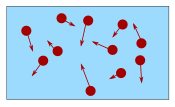Minus 22 Celsius To Fahrenheit
Conversion of Temperature
Quick Celsius (°C) / Fahrenheit (°F) Conversion:
measure out/images/thermometer.js?mode=boxes
Type a value in either box
Or use the slider
Or the Interactive Thermometer
Or this method:
| °C to °F | Carve up by five, and then multiply by nine, then add together 32 |
| °F to °C | Deduct 32, then multiply by 5, then split by 9 |
(Explanation Beneath ...)
Typical Temperatures
(only bold are exactly the aforementioned)
| °C | °F | Description | |
|---|---|---|---|
| 220 | 430 | Hot Oven | |
| 180 | 360 | Moderate Oven | |
| 100 | 212 | H2o boils | |
| 40 | 104 | Hot Bath | |
| 37 | 98.half-dozen | Body temperature | |
| 30 | 86 | Beach weather | |
| 21 | seventy | Room temperature | |
| x | fifty | Cool Day | |
| 0 | 32 | Freezing betoken of water | |
| −18 | 0 | Very Common cold 24-hour interval | |
| −40 | −40 | Extremely Cold Day (and the aforementioned number!) |

Some Tricks:
Daily Temperatures: these 3 conversions "flip the digits" (accurate within 1°):
°C °F
28 ⇄ 82
sixteen ⇄ 61
04 ⇄ forty
Oven Temperatures: in the range 150 to 200 °C we can double °C to get °F (accurate within eight°F):
| °C | °F Estimate | °F Actual |
| 200 | 400 | 392 |
| 180 | 360 | 356 |
| 160 | 320 | 320 |
| 150 | 300 | 302 |
Going the other way: for the range 300 to 400 °F we can halve °F to become °C (accurate within iv°C).
Explanation
In that location are two main temperature scales:
- °C, the Celsius Scale (part of the Metric System, used in nearly countries)
- °F, the Fahrenheit Scale (used in the US)
They both mensurate the aforementioned thing (temperature!), but use different numbers:
- Boiling water (at normal pressure) measures 100° in Celsius, but 212° in Fahrenheit
- And every bit water freezes it measures 0° in Celsius, but 32° in Fahrenheit
Like this:

Looking at the diagram, notice:
- The scales first at a unlike number (0 vs 32), so we will demand to add or decrease 32
- The scales rising at a different rate (100 vs 180), so we will also demand to multiply
And then, to convert:
from Celsius to Fahrenheit: commencement multiply past 180 100 , then add 32
from Fahrenheit to Celsius: first subtract 32, and then multiply past 100 180
180 100 can exist simplified to 9 5 , and 100 180 tin can be simplified to five nine , so we get this:
°C to °F: Divide by 5, so multiply by 9, and then add 32
°F to °C: Decrease 32, then multiply by five, then split by nine
Example: Catechumen 25° Celsius (a nice warm day) to Fahrenheit
Kickoff: 25° / 5 = v
And so: 5 × ix = 45
And then: 45 + 32 = 77° F
Case: Convert 98.half dozen° Fahrenheit (normal body temperature) to Celsius
First: 98.half-dozen° − 32 = 66.6
Then: 66.vi × 5 = 333
Then: 333 / nine = 37° C
We can swap the club of split and multiply if nosotros want, just don't change the add or subtract. And then this is also OK:
Example: Convert 98.6° Fahrenheit to Celsius (once more)
First: 98.six° − 32 = 66.6
Then: 66.vi / 9 = 7.4
Then: 7.4 × 5 = 37° C
(Same answer as before, was it easier or harder this way?)
Celsius to Fahrenheit: (°C × 9 v ) + 32 = °F
Fahrenheit to Celsius: (°F − 32) × v ix = °C
Other Methods That Work
Use one.8 instead of 9/5
ix/5 is equal to 1.8, so we can as well use this method:
Celsius to Fahrenheit: °C × 1.8 + 32 = °F
Fahrenheit to Celsius: (°F − 32) / ane.8 = °C
To brand "×1.8" easier we can multiply past ii and subtract 10%, only information technology only works for °C to °F:
Celsius to Fahrenheit: (°C × ii) less 10% + 32 = °F
Example: Catechumen 20° Celsius (A nice day) to Fahrenheit
- 20x2 = 40
- less 10% is 40−4 = 36
- 36+32 = 68° F
Add 40, Multiply, Decrease twoscore
Since both scales cross at −twoscore° (−40° C equals −twoscore° F) we can:
- add 40,
- multiply by v/9 (for °F to °C), or 9/5 (for °C to °F)
- decrease xl
Like this:
Celsius to Fahrenheit: Add 40, multiply by 9/5, and then subtract forty
Fahrenheit to Celsius: Add 40, multiply by 5/ix, and then subtract 40
Example: Catechumen 10° Celsius (A cool twenty-four hours) to Fahrenheit
- 10+40 = 50
- 50×9/5 = 90
- 90−forty = 50° F
Quick, but Not Accurate
Celsius to Fahrenheit: Double, then add together xxx
Fahrenheit to Celsius: Subtract thirty, so halve
Examples °C → °F:
- 0° C → 0+30 → 30° F (low by 2°)
- ten° C → 20+30 → fifty° F (verbal!)
- 30° C → 60+30 → 90° F (high by iv°)
- 180° C → 360+30 → 390° F (loftier by 34°, not good)
Examples °F → °C:
- 40° F → x/2 → 5° C (almost right)
- fourscore° F → 50/2 → 25° C (low by about two°)
- 120° F → 90/2 → 45° C (depression by about 4°)
- 450° F → 420/ii → 210° C (low by well-nigh 22°, not adept)

Footnote: Temperature is a measure of how fast an object'due south particles are moving.
1041, 1042, 1043, 1044, 3724, 3725, 3726, 3727, 3728, 3729
Minus 22 Celsius To Fahrenheit,
Source: https://www.mathsisfun.com/temperature-conversion.html
Posted by: crofootithoust.blogspot.com


0 Response to "Minus 22 Celsius To Fahrenheit"
Post a Comment